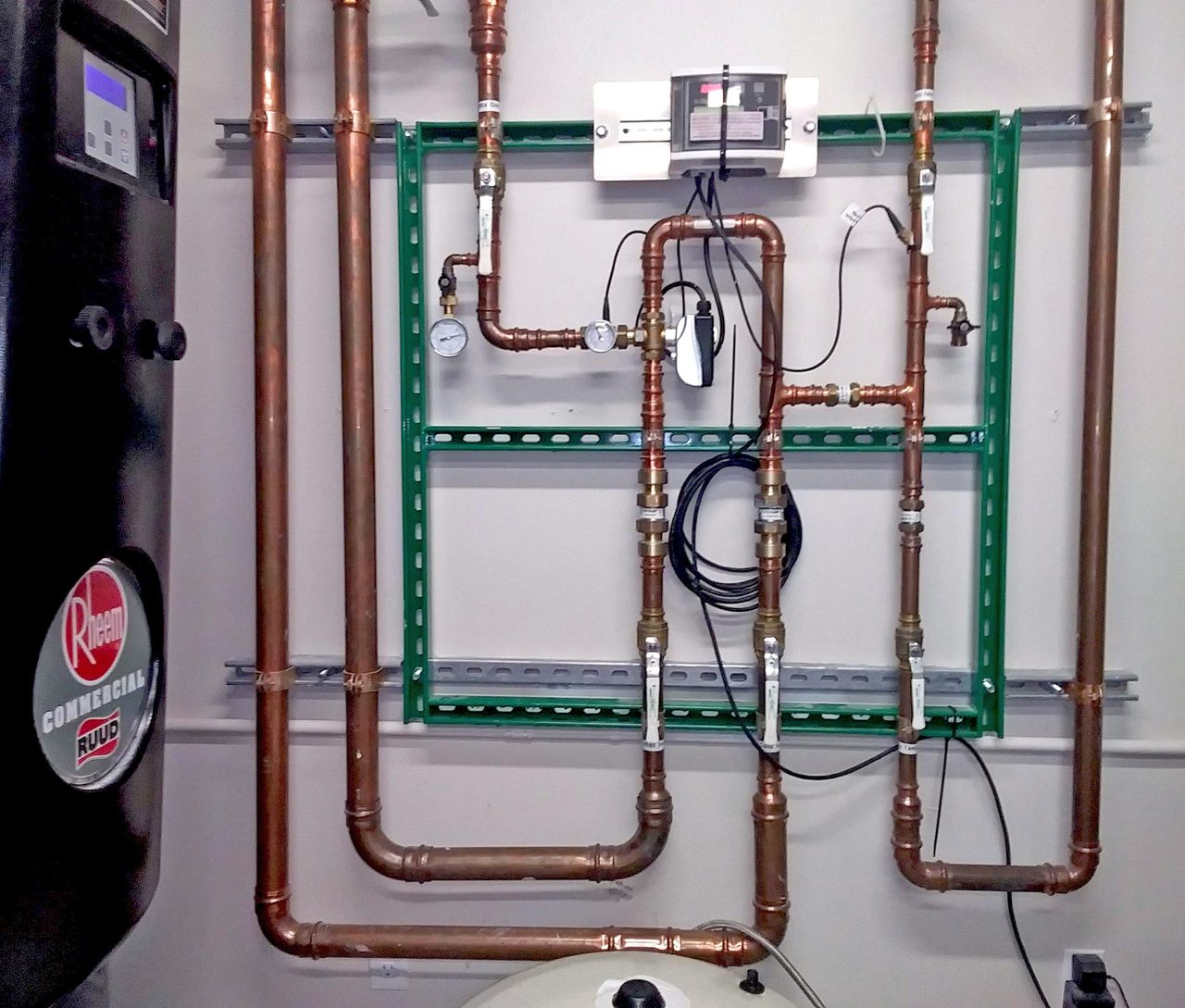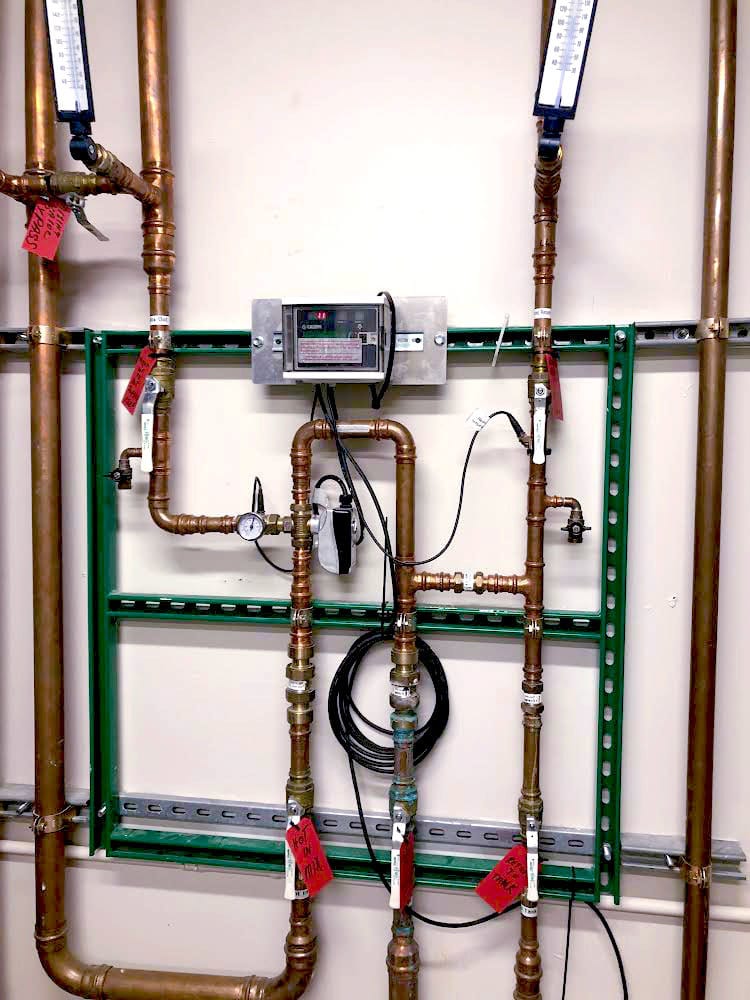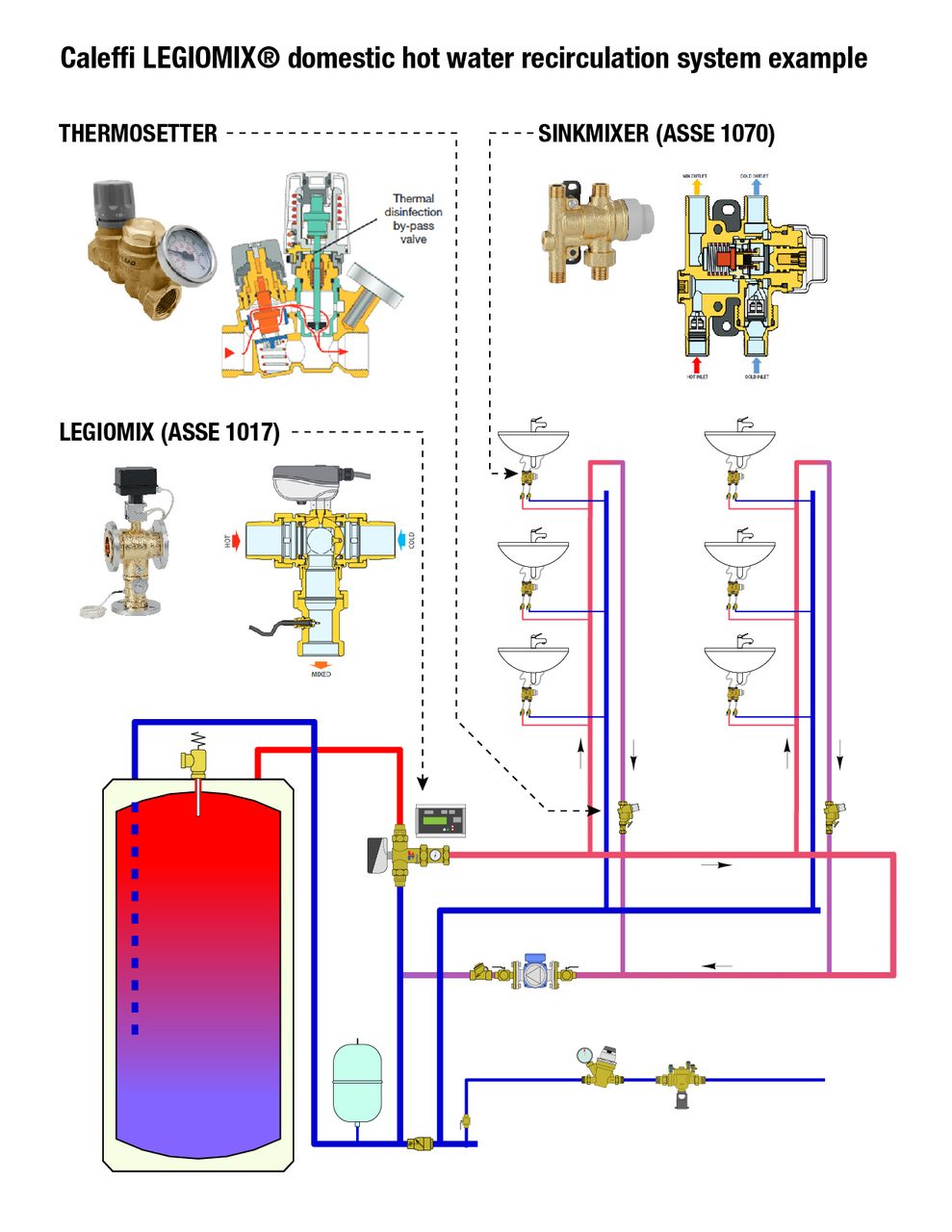Scald prevention valves: The last line of defense
DHW recirculation system provides accurate balanced tempered water control for new hotel.
By Max Rohr
Caleffi SinkMixer valves under each of the sinks. These products are perfect for single bathroom sinks. The four 3/8-inch compression connections and included mounting bracket make it easy for contractors to install, with no additional cold tee required.
Scald protection valves are the last line of defense in protecting occupants from dangerously hot water in plumbing systems. Point-of-use mixing valves keep building occupants safe and enable a variety of important domestic hot water recirculation applications. How are designers using scald protection mixing valves to advance the broader topic of DHW recirculation?
An ASSE 1070 compliant thermostatic mixing valve, often called a point-of-use mixing valve or scald protection valve, combines hot water from a DHW source, with or without a recirculation pump, with cold water to deliver safe, tempered water to the fixture “hot” inlet. The valves have a maximum set point adjustment of 120° F and can be set even lower, for example 115° F or 110° F, to meet specific building requirements and even individual room-to-room needs. The valves require a tool for temperature control in order to prevent occupants from casually adjusting the setpoint.
How are point of use valves being utilized? In a new construction hotel project in Florida, Performance Plumbing installed point-of-use mixing valves to meet the design criteria for the building. The system was designed in conjunction with architectural firm Harter-Adams and engineering firm Joseph, Lawrence and Co. Consulting Engineers.
Randal Langley is the vice president of Performance Plumbing in Naples, Forida. Founded in 2002 by Larry Langley, this family business has successfully tackled plumbing and gas line projects, ranging from custom homes to multi-family to industrial construction. Langley’s team won the bid to complete the ground-up plumbing and natural gas line installations for this hotel project. In the mechanical room, the company installed two Rheem 120 gallon water heaters and a 120 gallon storage tank.
Performance Plumbing was introduced to the Caleffi LEGIOMIX domestic hot water recirculation system by manufacturers’ representatives Marsh & Moore. This package consists of three components: A LEGIOMIX digital master mixing valve, ThermoSetter thermal balancing valves and SinkMixer point-of-use mixing valves.

In a new construction hotel project in Florida, Performance Plumbing installed point-of-use mixing valves to meet the design criteria for the building.
Together, these three components promote energy efficient and sanitary DHW recirculation system design. In addition to providing accurate balanced tempered water control, the system can be configured to automatically control Legionella bacteria using thermal disinfection cycles. Most importantly, it protects occupants from scalding, even during the thermal disinfection cycle. This trifecta of components was named one of three finalists for the 2022 AHR Innovation Awards in the Sustainability category. Reducing energy waste and hot water wait times make this system an important, sustainable solution for designers.
Performance Plumbing chose the 1 1/4-inch LEGIOMIX Station. This factory-fabricated rack system includes all the proper check valves, isolation ball valves and sensors pre-assembled and pre-wired in a small, ready-to-mount footprint. The unistrut rack is easy to install and reduces installer guesswork. The LEGIOMIX valve exercises the control ball valve an entire open and close cycle once a day to wipe away scale buildup. This feature is especially important in hospitality applications where there is no ideal downtime to remove and descale a mixing valve.
In past projects, balancing the hot water lines in an entire hotel involved a lot of time and money. In the planning stage, Langley was intrigued by the concept of this LEGIOMIX system, but was a little apprehensive. Instead of manually balancing each branch of the recirculation system, they were going to set the balancing valves to the desired system temperature and walk away.
“I was a little leary of the thermal balancing valves — you always are the first time, but it worked really well,” Langley notes. “You don’t have to go through and adjust everything, you just go through and start it up. It saved us a day or more to not have to balance.”

The LEGIOMIX valve exercises the control ball valve an entire open and close cycle once a day to wipe away scale buildup. This feature is especially important in hospitality applications where there is no ideal downtime to remove and descale a mixing valve.
ThermoSetter balancing valves modulate based on actual branch/riser temperature. As an example, if one floor of a large hotel is close to the heat source and another is at the far end of the recirculation loop, the valves near the heat source will respond to the system conditions and automatically close toward a minimum flow coefficient (Cv) to force the hot water to other branches that need the hot recirculating water.
With the master mixing and balancing components set, Performance Plumbing finished the system with “H-pattern” Caleffi SinkMixer valves under each of the sinks. These products are perfect for single bathroom sinks. The four 3/8-inch compression connections and included mounting bracket make it easy for contractors to install, with no additional cold tee required. For larger flow rates, such as a bank of sinks in a public lobby restroom, it is best to move to a larger scald protection valve such as the Caleffi TubMixer 5213 series mixing valve. These valves are perfect for roman tubs and high-flow fixtures.
After everything was installed, Langley called the Caleffi technical support line for help programming the electronic mixing valve. In under an hour, they had the whole building up and running with the appropriate settings.
“They made it convenient to get it done,” Langley says. “We’d love the opportunity to do another hotel like this, and would do it the same way.”
The expertise of the Performance Plumbing crew made this job a success and set up the hotel to have happy guests with clean, hot water when they need it.
The baseline design for DHW recirculation can be wasteful and dangerous if improperly designed or constructed. In some cases, water is stored and circulated excessively hot in order to satisfy the most hydraulically remote fixture. Other times, the recirculation lines are unbalanced or uninsulated, requiring warmer mixed outlet temperatures to keep all fixtures happy. These factors all come into play to create a scenario where scalding could occur without the proper protection. The point-of-use mixing valve is the gatekeeper. They enable thermal disinfection, energy saving recirculation and short wait times for hot water, while never losing focus on the scald prevention task at hand.

ENLARGE
There is no way to advance DHW recirculation systems without point-of-use mixing valves. Reducing water waste and improving energy efficiency of water heating systems does not inherently protect occupants from scalding. By including scald protection valves, system designers, installers and maintenance personnel can address emerging challenges, like Legionella bacteria management and prevent scalding in the process.

SinkMixer valve photo courtesy of CALEFFI. Hotel images courtesy of Performance Plumb
Max Rohr is the education and training manager for Caleffi Hydronic Solutions. Rohr has worked in the plumbing and hydronics industry since early childhood with his father, Bob “Hot Rod” Rohr. He holds a bachelor’s degree in behavioral science and health from the University of Utah.
